
Switzerland - Bern-Lötschberg-Simplonbahn, BLS Group
For a full scale picture, please click on the picture shown !
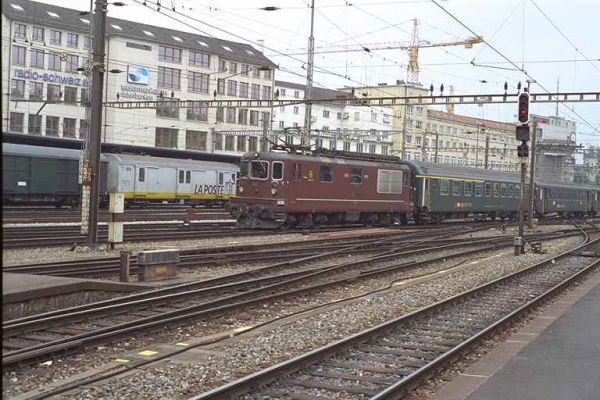
BLS, or as their full name is, Berner Alpenbahn Gesellschaft Bern-Lötschberg-Simplon, is one of the "big" rail companies of
Switzerland. It is privately owned, but the state SBB has a minority stake in the company. It operates trains on
almost all normal gauge and normal electricity rail lines in the country, even visiting Germany close to Basel, but their
"home ground" is the Lötschbergbahn route from Bern to Thun and Spiez close to Interlaken, up the valley to Kandersteg and
then through the world famous Lötschberg line to Goppenstein, down to Visp and Brig in the next valley and further through
the Simplonpass to Italy, Domodossola, where it connects to the Italian line to Milano. The Lötschberg line was opened in
1913 and it was a world sensation. For example, trains make full turns inside a mountain and pass one and the same lake
three times at different elevations while climbing up the Lötschberg. But nowadays only a few trains use the old scenic route.
Most of the traffic runs under the montains now that a new Lötschberg "basis tunnel" has been opened.
Key services of the BLS group are: 1) they run the majority of the local commuter train services ("S-Bahn") of the Bern area,
2) they run a successful cars-on-train ("Rollende Landstrasse") service every 15-30 minutes through the mountain between
Goppenstein and Kandersteg (and during the summer from Domodossola to Kandersteg) and 3) they run a big and lively cargo
business in co-operation with the French SNCF from Germany to Italy. SNCF owns a part of BLS Cargo. Although the state SBB is a part owner and has
placed many of its own new locomotives in the BLS blue house colours to operate BLS services, BLS and SBB have also
been bitter rivals for years. In 2001-02 it was announced that BLS Lötschbergbahn
stopped operating express trains and express train coaches (e.g. between Basel and Brig or Italy) and handed all their
long distance coaches over to SBB and SBB on the other handed over the Bern area S-Bahn traffic to BLS.
This is BN Re 4/4 I no. 180 in Bern, 19 September 1995.
The Bern-Neuchâtel Railway BN was a part of the "Bern-Lötschberg-Simplon" group before it became totally integrated into BLS
Lötschbergbahn.
Photo by Erik Hjelme.
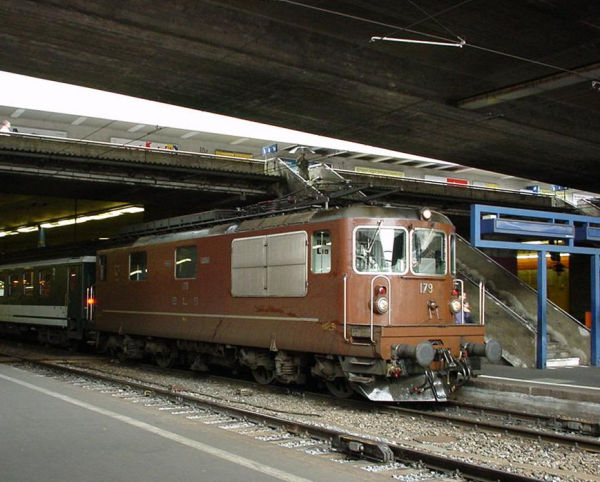
BLS Lötschbergbahn Re 4/4 locomotive no. 179 doesn´t much resemble the looks of later versions
of type Re 4/4. While the SBB was first time experimenting with direct drive electric motors on the axels,
the BLS went on to thyristor technology and built 35 of these - that time - powerful locomotives in
three series for their steep Lötschberg ramps. In fact these locomotives are among some of the very
earliest to be based on modern thyristor steered AC technology, although their looks are almost directly
from the SBB´s Re 4/4 1. series of the fourties. These BLS engines were
really ahead of their time in the seventies. They were first designated Ae 4/4 II series, but were
later renamed Re 4/4, adding to the vast confusion of different locomotives with that same "name".
This no. 179 is of the last BLS series, built in 1972. It is 15,47 meters long, weighs 80 tons, generates
4 990 kW of power and has a maximum speed of 125 km/h. Here it is pulling an SBB express train bound for
the BLS Lötschberg line and Italy. Usually it was mainly used with lighter passenger trains and car-on-train
"Rollende Landstrasse" services along the Lötschberg - Simplon axle.
In today´s new numbering scheme this engine is designated Re 425 no. 179. (In the old numbering Re means
rapid and electric and 4/4 means that all 4 axles out of 4 deliver power. In the new numbering the first
4 indicates it´s a 4/4 series locomotive, the 2 indicates it is from second generation [number 1 would be
the Re 4/4 1. series of SBB from 1948] and the last 5 indicates the owner, the BLS group).
Photo from Bern station in June 1999 by Ilkka Siissalo.
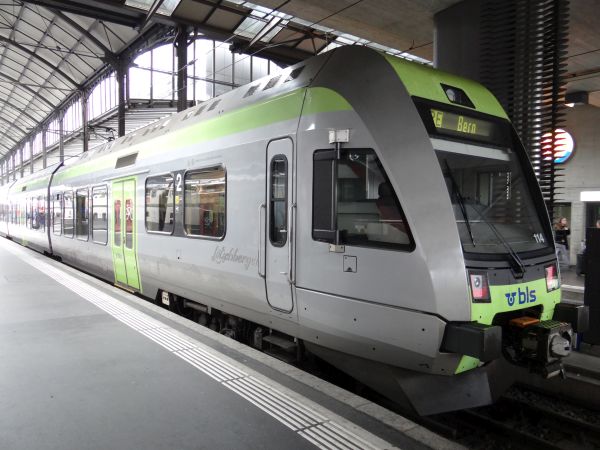
The RABe 535 "Lötschberger" is a new electric multiple unit type, which has largely superceded locomotive
pulled BLS trains on routes such as the Bern to Neuchatel and Bern over the Lötschberg mountain pass to Brig
routes. They were built by Vevey Technologies and Bombardier at Bombardier's Swiss factories in Vevey
2008-2009. It's a 160 km/h fast EMU with a power rating of 1000 kW. There are 28 seats in first class and
143 in second class.
Picture from Luzern 1.5.2016 by Ilkka Siissalo.
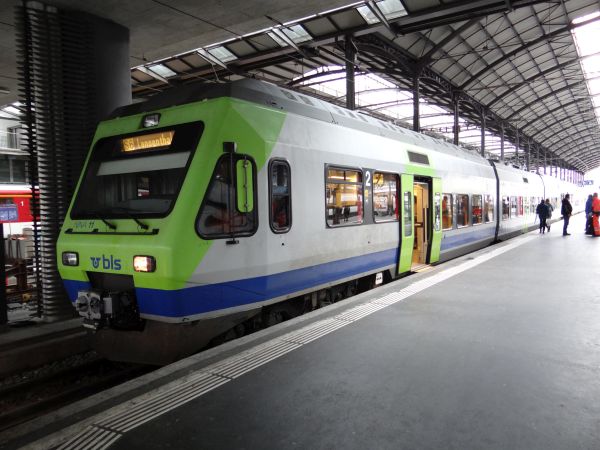
This is a so called NINA train of BLS. NINA stands for Niederflur-Nahverkehrszug or low floor commuter train. They are
actually the train class BLS RABe 525 and they were built by Bombardier, Alstom and Vevey Technologies 1998-2001.
They have mainly been used in the Bern area local commuter traffic. NINA has been a very much liked train type and
actually BLS would have wanted to buy more of them 2007-2008, but security legislation and requirements had been changed.
The end result was the newer but similar type Lötschberger which is pictured above. NINA trains had originally 28
first class and 143 second class seats, but during renovations first class has now been removed as unnecessary in
short haul commuter traffic. Top speed of the NINA trains is 160 km/h and just like the later Lötschberger trains, they
also have a power rating of 1000 kW. NINA is 85% low-floor.
Picture from Luzern 1.5.2016 by Ilkka Siissalo.
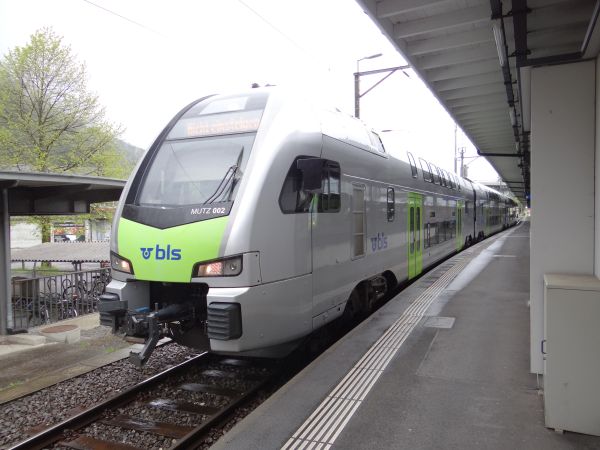
This doubledecker regional and commuter train type is made by Stadler and Stadler calls it Stadler KISS, but BLS has named its
KISSes "MUTZ". Mutz is Bernese dialect and means bear. There is a bear depicted in the emblem of the city of Bern. BLS uses these
MUTZ-trains mainly in their Bern to Interlaken traffic. According to BLS their shorthand MUTZ stands for Modern, Universal Multiple
Unit Train. Officially it is called class RABe 515. It is a fixed set of four double decker coaches and a maximum of four units
can be combined yielding a 16 coach train which can take up to 1340 people. Their maximum speed is 160 km/h.
Picture from the station Interlaken Ost 1.5.2016 by Ilkka Siissalo.
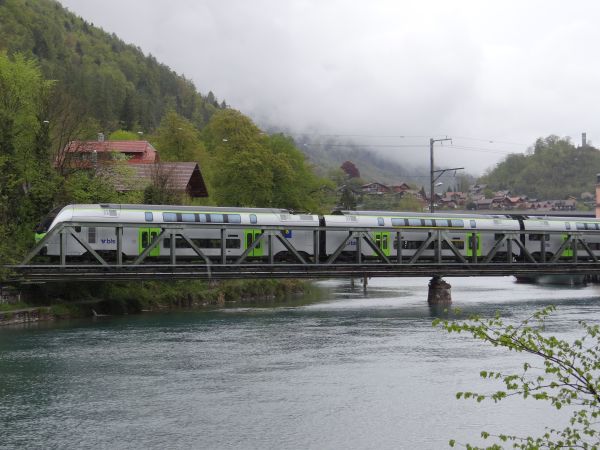
A BLS MUTZ train is crossing a river quite next to the station of Interlaken Ost.
Picture from the station Interlaken Ost 1.5.2016 by Ilkka Siissalo.
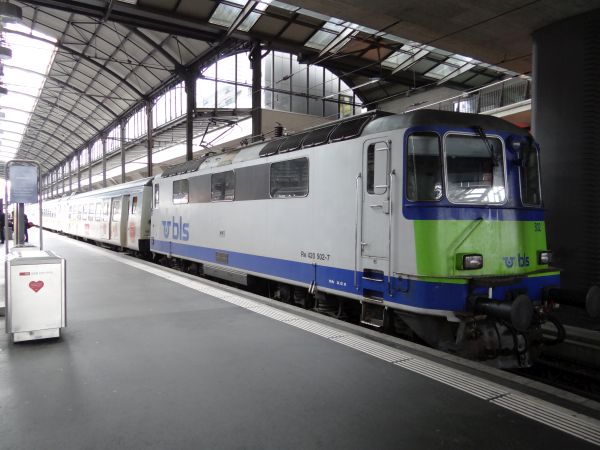
In 2004 BLS bought from the Swiss federal railways SBB used so called Swiss Express trains consisting of sets of EW III
(Einheitswagen III, standard coach III) and locomotives of the type Re 4/4 II. BLS renamed the locomotives to Re 420.
This is one of those locomotives and coach sets. This coach set was taped with advertisement tapings of the biscuit
factory Kambly and therefore this one train got the nickname "Kambly-Zug". There were even H0 scale model trains made of this train.
Picture from Luzern 1.5.2016 by Ilkka Siissalo.
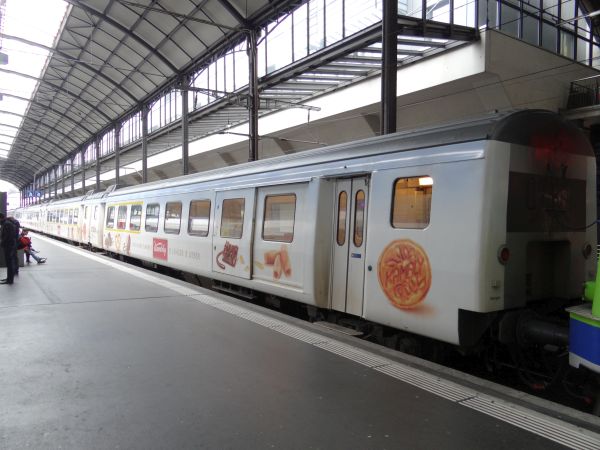
The "Kambly-Zug" or set of EW III coaches of BLS all covered with advertisements of biscuits made by the biscuit factory Kambly.
Picture from Luzern 1.5.2016 by Ilkka Siissalo.
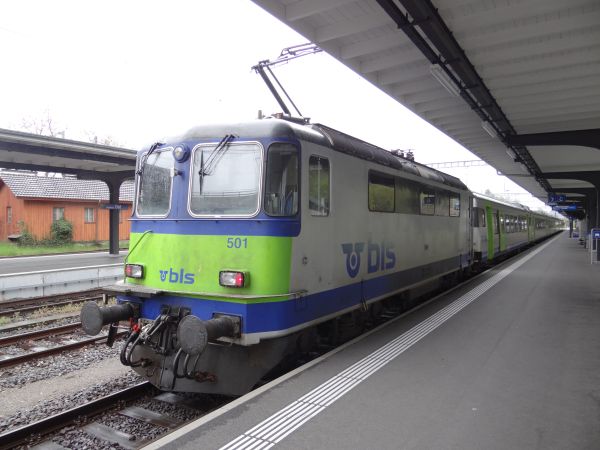
A similar train like the one pictured above, composed of one old Re 420 locomotive and a fixed rake of EW III coaches, but this time in BLS'
regular livery and not in a biscuit company advertisement painting as above. When these same trains were still used at the federal railways
SBB these trains used to be called Swiss Express and they were painted orange and creme.
Picture from Interlaken Ost station 1.5.2016 by Ilkka Siissalo.
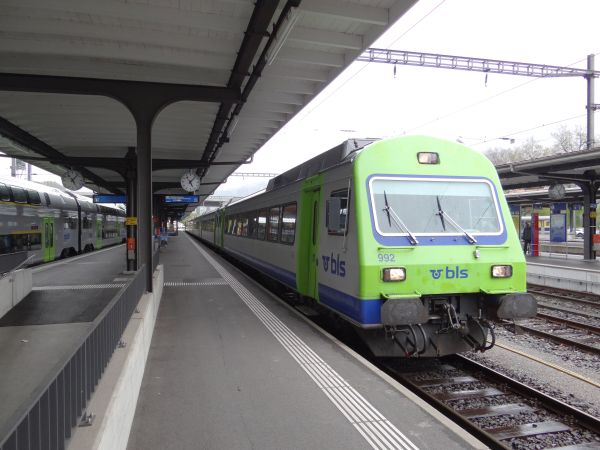
Same train as above, but seen from the other side. This is the steering cab coach of a former Swiss Express train (EW III coach).
Picture from Interlaken Ost station 1.5.2016 by Ilkka Siissalo.
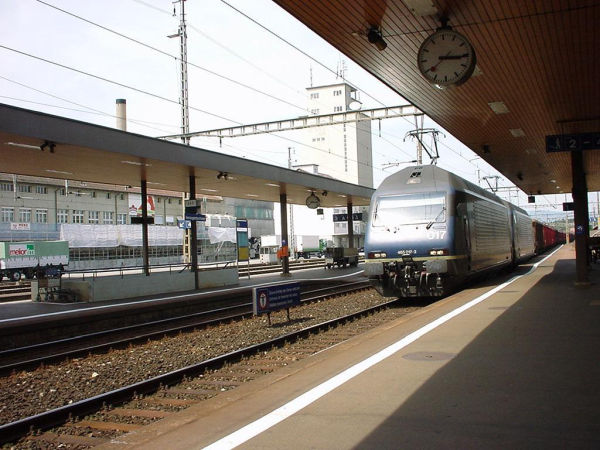
Extremely heavy cargo train led by two BLS Re 465 locomotives in full speed between Basel and Bern,
a fraction of a second before passing the photographer, on the way to the Simplon line and south to
Italy. The Re 465 is a modification of the Re 460, the so called "Lok 2000", the former pride of Switzerland.
Re 465 is 18,5 metres long, weighs 84 tons and has a maximum speed of "only" 230 km/h. Difference
between the original Lok 2000 alias SBB`s Re 460 and the 465 is that the 465 has been adapted for use
on the extremely steep slopes of the Simplon mountain line; therefore it is slower but stronger. The
company BLS, Bern-Lötschberg-Simplonbahn, has 8 of its own of these blue beauties and in addition to
that the state SBB, part owner of BLS, bought 1996-97 a further ten (numbers 009-018; so this one we
see is actually an SBB locomotive) and painted them in the blue colours of the BLS. The original painting
of the Lok 2000 is bright red, as seen at the SBB Re 460s. Matter of taste, but I find the BLS blue more
attractive. The stylish design of the locomotive is from the famous Italian design company Pininfarina.
The picture actually shows a modern paradox: an SBB locomotive in "enemy colours" pulling a cargo train
for the competitor of SBB. This is a typical train pulled from Germany with BLS engines all the
way through the Simplon pass.
Photo from Herzogenbuchsee station in October 1999 by Ilkka Siissalo.
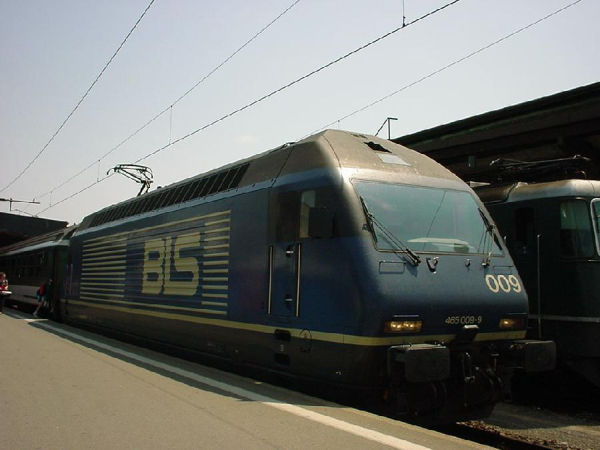
Re 465 no. 9 of the BLS, Bern-Lötschberg-Simplonbahn at Zürich Hauptbahnhof station ready to take an SBB passenger train
across the Alps to Italy. The Re 465 is otherwise the same "Lok 2000" locomotive as the Swiss national railroad SBB´s famous
Re 460, except that it has been slightly modified for slower speed ("only" 230 km/h) and higher power (7000 kW vs. 6100 of the
SBB Re 460) for use at the Lötschberg mountain line. The first series, numbers 1 to 8, were built in 1994. This one no.
9, belongs to the second series, no. 9-18, built in 1996 and actually is not owned by the BLS but by the SBB, despite the BLS
paintings. SBB ordered these engines for the so called NEAT transito traffic along the Lötschberg - Simplon - Italy
mountain line, but lets BLS operate and maintain the engines.
Picture from Zürich in June 1999 by Ilkka Siissalo.
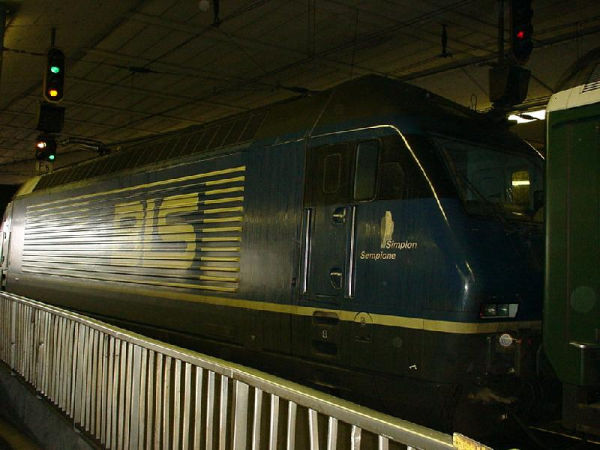
Glistening from rain, the BLS Lötschbergbahn Re 465 locomotive "Simplon" has just led an SBB express train from the other side
of the Alps to the Bern station. Now it´s time for the state SBB to put their own locomotive once again in front of their train
while "Simplon" will lead another train back to the Lötschberg tunnels and - Simplon. The picture shows well the famous Italian
Pininfarina design of the "Lok 2000" engine. Basically the same engines have also been exported, most notably to Norway and to
Finland. German DB was also highly interested, but opted instead to create a new design themselves because of "the astronomic costs
of the Swiss engine": about 3 times the cost of their Br 101, which made it "impossible to afford such luxury". Their cheaper
design became the Br 101, which still today is the main locomotive on long-haul IC and EC trains in Germany.
Photo from Bern 1999 by Ilkka Siissalo.
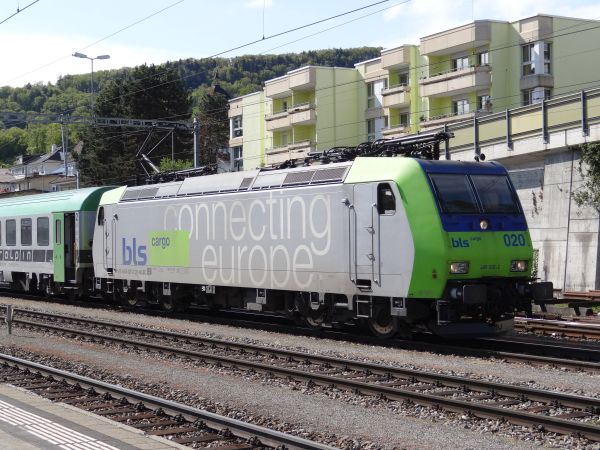
A typical locomotive of BLS Cargo today, this is the Re 485 (equal to Br 185 of Germany). It is a Bombardier TRAXX MS multiple
electric systems locomotive, which can - at least in theory - pull a train all the way for example from Holland via Germany and Switzerland
right into Italy. BLS uses nowadays many TRAXX family machines.
Picture from Spiez 2.5.2016 by Ilkka Siissalo.
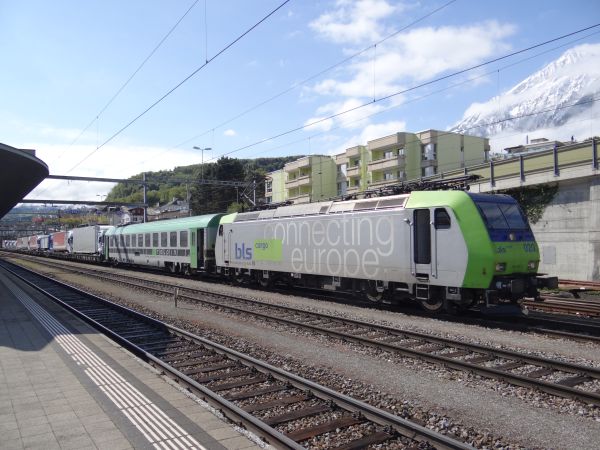
The same train as above. It is here leading a "Rollende Landstrasse" (rolling highway) service bringing lorries from Italy over the Alps to Germany.
Lorry drivers can rest in the attached sleeperette coach while their trucks are being hauled over the Alps - or rather, under the Alps, as it most often is today.
Picture from Spiez 2.5.2016 by Ilkka Siissalo.
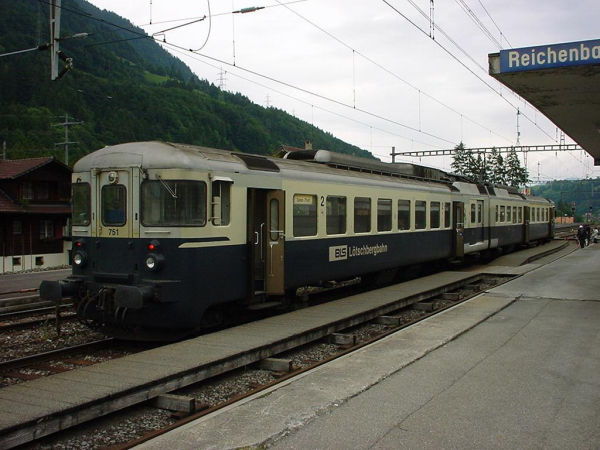
This ABDe 4/8 number 751 of the BLS Lötschbergbahn is the first one built in 1964, in the third series of similar
trains. The first series was built in 1945 (see the pictures from Önsingen-Balsthal-Bahn OeBB ABDe 4/8),
the second series in 1954 to -57. Ten years later BLS ordered a further four of almost exactly similar short distance
commuter trains. The trains were designed for S-Bahn local commuter traffic around the capital, Bern. This third
series from the sixties differs from the earlier ones by a "newer" front design which resembles the Re 4/4
locomotives of BLS of that time (see bls-re425-179.jpg). The electrical parts of these trains were modernised
in 1977, which allowed for a higher maximum speed of 125 km/h.
The two-coach unit is 46,8 metres long, weighs
102 tons (sic! - _thick_ iron!), but generates a modest 1180 kW of power. The original ABDe 4/8 pair was designed
in 1945. The idea was that these pairs could form trains which could be used for through-the-Alps traffic all
the way to Italy. This was however never realised and the trains have been in valley line traffic around Bern.
The very last trains of this kind were still in use on less-than-important local commuter routes like here between Reichenbach
and Thun in 1999.
Photo from Reichenbach station in June 1999 by Ilkka Siissalo.
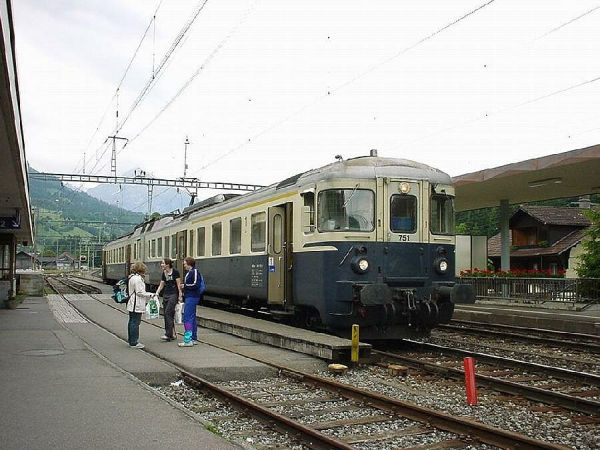
Another view of the BLS Lötschbergbahn ABDe 4/8 no 751. This electric motor unit was a fixed two coach pair. The electric
systems of these trains were built in 1964 and renewed in 1977, raising the maximum speed to 125 km/h. From three different
series, there are 13 of these pairs, 10 of which were in 1999 still operating under the blue-white colours of the BLS.
Three pairs of the oldest series from 1945 were already in 1999 sold to two other private railroads, OeBB and RVT. Originally,
the trains were designed in the fourties to be retrofitted with a second drive system to accommodate also the differing voltage
in Italy in order to allow short-haul passenger trains of this type to pass through all the way through to Domodossola in Italy.
This plan was never realised, but it explains why there is plenty of empty space on the roof to accommodate a second pantograph and
coolers.
Photo from Reichenbach station in June 1999 by Ilkka Siissalo.
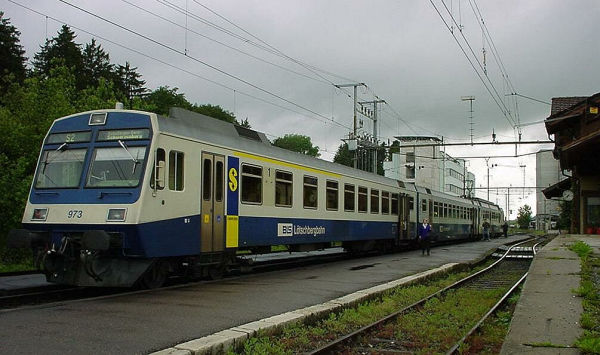
The RBDe 4/4 (or with the new numbering scheme RBDe 565) was built in three series between 1982 and 1991. It is still today used
in BLS´s short haul services, especially in the S-Bahn network around the capital Bern. It is very similar to
the RBDe 560 of the state SBB and in fact almost 1:1 identical with the prototype series of SBB´s trains, named NPZ or Neue
Pendelzug (new pendeling train). Still in the nineties similar or almost similar trains took care of the majority of traffic on other
private companies networks as well, such as EBT, GFM and RVT/Regionalverkehr Mittelland, SüdOstBahn, Bodensee-Toggenburgbahn,
MittelThurgauBahn and others. BLS had 22 of these units. Just like SBB also BLS later retrofitted old aluminium express train
coaches of the EW series ("Einheitswagen" - a similar coach used by the majority of Swiss companies) to be used as extra
coaches in the middle of the originally two-car units, but BLS and some other companies also later ordered middle coaches to
exactly fit into the look and feel of the NPZ trains. This picture shows one of those later "tailor-made" middle wagons. The
original two-coach unit is 25 metres long, weighs 69 tonnes, has a maximum speed of 125 km/h and generates 1700 kW of power.
Photo of the "S2" line S-Bahn of Bern close to the station of Belp in June 1999 by Ilkka Siissalo.
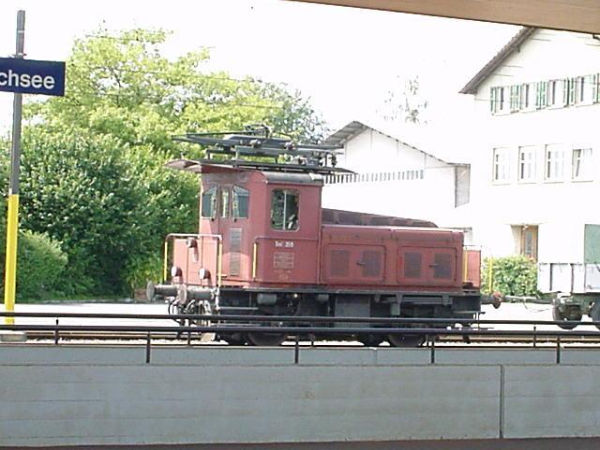
Every major station used to have its own permanently stationed locomotive in Switzerland in reserve and for swithcing work - a luxury
which was standard practise there but almost nobody else can afford. This means that the country was full of very small, most
often electric locomotives, most of which were officially classified as rail tractors. This example, Tm 215 of the BLS
Lötschbergbahn is a rarity - BLS only has this one - but almost exactly similar new locomotives were still built in the
beginning of the 1990s for other companies. For example the state SBB had over 200 of the Tm II series engines which looked
very similar to this one. The BLS Te 215 from 1925 (modernised 1956) was 8,13 m long, weighed 36 tons and had a maximum speed
of 50 km/h.
Photo from 1999 from Herzogenbuchsee by Ilkka Siissalo.
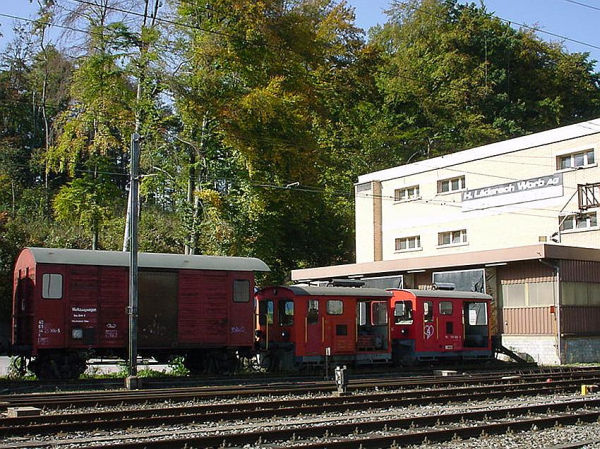
Two "rail tractors" or small helper locomotives of the type Tm 235 of the BLS Bern-Lötschberg-Simplonbahn. The
one in the middle, number 70, shows the original painting from years 1962-75, whereas the one on the right,
number 68, has undergone a total revision during 1993-95 and is now painted bright red. These small ones weigh
9,1 tons, they are 5,24 m long and they can pull a couple of coaches at speeds up to 45 km/h with their tiny
diesel engines.
Photo on 15.10.2001 at Bern-Weissenbühl station by Ilkka Siissalo.
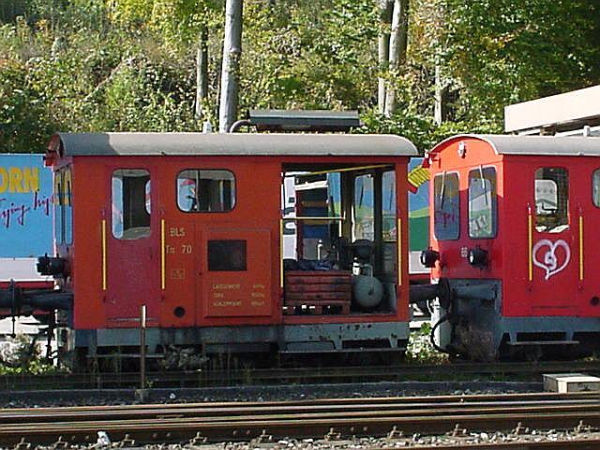
Closeup of the Tm alias Tm 235 (according to new numbering scheme) of the BLS, in the original state of the
sixties, having undergone no revision. In Switzerland it is the habit that almost every station, no matter
how small, has at least one small locomotive or "rail tractor" - as the smallest are usually called - always
present, just in case. They are rarely used and then when they are, it is just a matter of moving or switching
a wagon or two. The state railroad SBB usually has a bit bigger electric locomotives for this purpose, whereas
private companies such as the BLS have settled for something as small as one can get. Few other countries can
afford keeping tens of locomotives on every station just standing still, for just-in-case.
Photo on 15.10.2001 from Bern-Weissenbühl station by Ilkka Siissalo.

